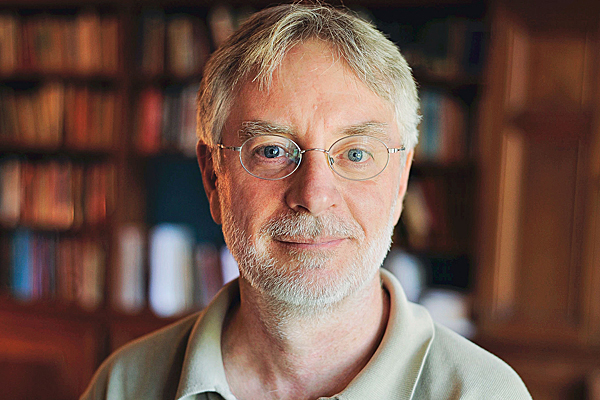In Review
 QUESTIONING: “All the most important questions in life can’t be answered objectively or decisively,” says Thomas Slaughter, who was named the first Arthur R. Miller Professor of History this year. (Photo: Richard Baker)
QUESTIONING: “All the most important questions in life can’t be answered objectively or decisively,” says Thomas Slaughter, who was named the first Arthur R. Miller Professor of History this year. (Photo: Richard Baker)Good historians offer fresh perspectives on people and events of the past we thought we knew well.
Thomas Slaughter, the Arthur R. Miller Professor of History, has not only consistently added new dimensions to old arguments, but has also questioned some of academic historians’ most basic methodological assumptions.
“I’m interested in history as an expression of creative nonfiction writing,” says Slaughter, who has written five books on early American history. And although Slaughter adds “I never write anything that everyone likes,” his admirers speak in superlatives.
“In these days of tight academic specialization, Tom’s range as an American historian is breathtaking,” says Stewart Weaver, the chair of Rochester’s history department.
Michael Zuckerman, a noted scholar of early American history at the University of Pennsylvania, goes even further, declaring, “I believe flat-out that Tom is the most accomplished early American historian of his generation.”
Slaughter joined Rochester’s history department at the start of the 2008-09 academic year after occupying an endowed professorship at the University of Notre Dame. In his books on well-known subjects, such as the 1794 Whiskey Rebellion and the Lewis and Clark expedition, and most recently in his biography of the Quaker spiritual leader John Woolman, he has, in his own words, “pushed the boundaries between history and fiction.”
Slaughter stresses that historical writing is—and always has been—“fundamentally an act of the imagination.” Historians decide what questions to ask, construct and prioritize problems, and privilege some sources over others. With that, few historians would disagree. But Slaughter adds that historians have prized objectivity at the expense of other legitimate aims, namely addressing large and timeless questions that require delving into the minds of historical actors.
“History has two long traditions,” he says. In the 19th century, scholars urged that history be practiced scientifically, by advancing hypotheses that could be verified by the collection and presentation of evidence. But, Slaughter says, “there is an older and longer tradition in which history is a branch of literature.” In his view, the field benefits by a renaissance of the literary approach.
He is not merely urging that historians be engaging storytellers, which many already strive to be. Instead, he suggests a greater dose of empathy and intuition in historical writing than many of today’s academic historians would be willing, or even able, to integrate into their highly analytical works. As a result, accolades for his work also include an occasional mention of an “unsupported claim” or a leap of faith.
But Slaughter’s willingness to take risks allows him to explore areas that other historians would not.
For example, his latest book, The Beautiful Soul of John Woolman, Apostle of Abolition, is one “only Tom could have written,” says Weaver. Zuckerman agrees. “It’s not for nothing that scholars have so conspicuously avoided John Woolman,” he says.
Woolman’s name resonates throughout the 19th-century movement to abolish slavery, even though the Quaker mystic was dead by 1772. And although abolitionists cited him as the spiritual founder of their movement, virtually the only source historians have on Woolman’s life is his autobiography, which, in conforming to the traditional Quaker narrative of fall, rebirth, and insight, is really “the lock rather than the key to understanding Woolman,” Slaughter says.
Slaughter says comprehending Woolman—and his profound effect on abolitionists—required “understanding how his mind works.” Thus Slaughter immersed himself in all the works of Quaker theology that Woolman read and studied. That context would inform the intuitive interpretation of Woolman that is the book’s most defining characteristic.
This spring, Slaughter brings timeless questions to the classroom with a new course entitled Just Wars. Students read multiple works in Just War Theory, an interdisciplinary body of thought composed of theological, political, and legal writings that today informs international law. Then, they study a war and apply the theory to the conflict’s particulars to answer the fundamental question: Was it a just war?
The course grew out of Slaughter’s current project, tentatively titled “Independence: The Beginnings of the United States.” In addition to situating the American Revolution in a world historical context that considers the impact of distant economic and political forces, Slaughter has raised a question that he is amazed no scholar of the American Revolution ever has before: Was the Revolutionary War a just war?
A provocative question, to be sure. But its challenge to conventional perspectives on the Revolution is precisely what Slaughter finds intriguing.
“All the most important questions in life can’t be answered objectively or decisively,” he says. “And history shouldn’t be bound by the small questions.”
